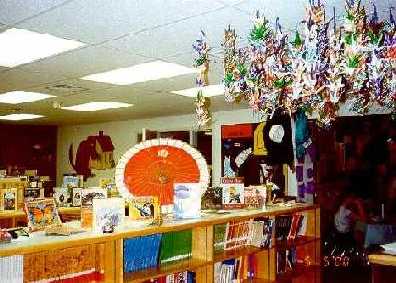Japanese culture brought home to students |
|
Susan Springer's class began a new unit about Japan Tuesday with a visit from Lorraine French, a Terryville High School teacher and Fulbright Scholar. Springer's class will also take part in the "Friendship Doll Program," organized by the Spokane, Washington-based Mukogawa Fort Wright Institute. The doll program is based on a similar one begun in 1927 to help American and Japanese students learn more about each other. For the original program, Dr. Sidney L. Gulick enlisted people in either country to create dolls representative of their culture. Then, the dolls were sent to the opposite side of the Pacific. "He thought the way to bridge the gap between the two countries was through children," Springer said of Gulick. During World War II, people in both the U.S. and Japan were known to have either destroyed or hidden the original dolls because of the animosity between the nations, Springer said. But a few years ago, one of the Japanese dolls, named "Miss Chosen," was discovered buried in a box at the Science Center of Connecticut [name changed to The Children's Museum in 2006] in West Hartford. While Miss Chosen is not yet on display, Springer's class will visit the doll at the museum on March 1.The following day, Springer and city schools' Media Coordinator Barbara St. Onge will travel to Spokane to accept the gift of a Japanese doll being given to the Bristol Public Schools from the Mukogawa Fort Wright Institute. The Institute has rekindled the doll program to bring diversity lessons to students in America and in Japan, Springer said. While in Washington, Springer and St. Onge will take part in the Institute's celebration of Girls' Day, a holiday observed every March 3 in Japan. One of the highlights of Girls' Day is a doll ceremony where girls unpack and display their dolls, Springer said. Once the doll arrives in Bristol, it will be on display at Edgewood until the end of the school year, and then it will be located at the Bristol Public Library, where it may be borrowed by other classes for lessons.
On Tuesday, French's lesson featured a brief look at Japanese language, culture and society through the eyes of children. French visited schools in Japan during her Fulbright visit, and she compared the typical day of a Japanese child to those the Edgewood students are familiar with. After a morning of lessons, during which French showed excerpts of, the students eat lunch in their classroom. When the meal is complete, the students wash their hands, fix their hair and brush their teeth. After cleaning up themselves, the class sweeps the floor and each student is assigned a portion of the classroom floor to wash with a cloth. French said that since there are no custodians in Japanese schools, it becomes everyone's responsibility to keep the school clean. Students will also clean the hallways, she said. "What does that teach you?" French asked the Edgewood students. "Discipline," answered one. "To be responsible," added another. French said those were the same answers she received when she asked one Japanese teacher why it is so important for students to keep the school clean. "She said, 'We teach that there's honor in hard work,'" French said. French also brought a variety of tiny dishes and bowls used to serve Japanese cuisine, and a pair of chopsticks. She pointed out the intricate design on one soup bowl, and showed how a host would pass the bowl to their guest with the design facing the guest. Then, French said, the guest would admire the design and then turn the bowl so the design would face the host. That way, she said, everyone gets a chance to admire the beautiful bowl. "They're very considerate," French said of the Japanese people, "and that's where a lot of their customs come from." French cited other customs, such as the Japanese penchant for gift-giving. She had a number of small gifts that she received from people she met and stayed with while in Japan. "Japan is like an onion," French said as she picked up an onion and began peeling off its outer layer. "If you're there for a couple of weeks, you just take the skin off. It's a very complex place." Springer's class will also work with guest teachers and Japanese students from Teikyo Post University, go to a performance of Asian dances, and create their own research projects on life in Japan. The class will present their research projects on May 5, which is known as Boys' Day or Children's Day in Japan. |
